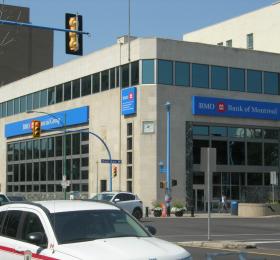Bank of Montreal
- Regular
Description of the Historic Place
The Bank of Montreal is a three-storey stone building that was built in 1955. Located in the city’s downtown at 101 2nd Avenue North, the Bank of Montreal building is an excellent example of the International style of architecture.
Heritage Value
The heritage value of the Bank of Montreal lies in its architectural style. Designed by Webster & Gilbert, the Bank of Montreal building exhibits rectangular modules, hard angular edges, plain surfaces, large expanses of glass and a flat roof – all features characteristic of the International style which was popularized during the mid-20th century. The stone building is trimmed with marble and granite.
The heritage value of the Bank of Montreal also lies in its association with Canada’s first permanent bank which dates back to 1817. The Bank of Montreal opened its first Saskatoon branch in 1906 in an old frame building on 2nd Avenue. The Bank of Montreal bought land to build a new bank in 1907 at the bank's current location. At the time, the location at the corner of 2nd Avenue North and 22nd Street was virtually outside of the town's limits, but within a couple of years, as growth of the city continued, the site was right in the middle of the now busy city centre. In 1909 a new bank was built on the corner lot. This building required alterations in 1918 and 1922 to cope with increased business when the Bank of Montreal took over clients from the Bank of British North America and the Merchants Bank of Canada.
In 1955 it was decided that a new, ultra-modern bank would be built. The Bank of Montreal office was temporarily transferred to 21st Street at the Great Western Furniture Co. building. The Greek-style 1909 bank was demolished and a new bank was built. Today, the grand design of the Bank of Montreal continues to be a prominent feature in the city’s downtown. The building received an award for sympathetic restoration under the City's Heritage Awards Program in 1998.
Source: City of Saskatoon Built Heritage Database
Character Defining Elements
Key elements which contribute to the heritage value of this historic resource include:
- Its International style of architecture, evident in: its form; rectangular modules; hard angular edges; plain surfaces; large expanses of glass and flat roof;
- Its stone façade with marble and bronze trim; and
- Its central location on the corner of 22nd Street East and 2nd Avenue North

